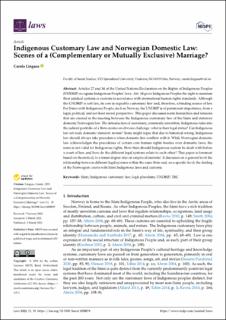| dc.description.abstract | Articles 27 and 34 of the United Nations Declaration on the Rights of Indigenous Peoples (UNDRIP) recognise Indigenous Peoples’ laws. Art. 34 gives Indigenous Peoples the right to maintain their juridical systems or customs in accordance with international human rights standards. Although the UNDRIP is soft law, its core is arguably customary law and, therefore, a binding source of law. For States with Indigenous People, such as Norway, the UNDRIP is of paramount importance, from a legal, political, and not least moral perspective. This paper discusses norm hierarchies and tensions that are created in the meeting between the Indigenous customary law of the Sámi and statutory domestic Norwegian law. The introduction of customary, commonly unwritten, Indigenous rules into the judicial portfolio of a State creates an obvious challenge: what is their legal status? Can Indigenous law set aside domestic statutory norms? Some might argue that due to historical wrong, Indigenous law should always take precedence when domestic law conflicts with it. While Norwegian domestic law acknowledges the precedence of certain core human rights treaties over domestic laws, the same is not valid for Indigenous rights. How then should Indigenous custom be dealt with before a court of law, and how do the different legal systems relate to each other? This paper is foremost based on theoretical, to a lesser degree also on empirical material. It discusses on a general level the relationship between different legal systems within the same State and, on a specific level, the dealing of the Norwegian courts with Sámi Indigenous laws and customs. | en_US |

